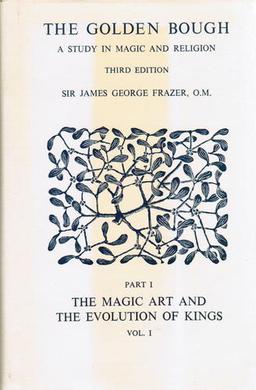
Carlos Castañeda was an American writer. Starting in 1968, Castaneda published a series of books that describe a training in shamanism that he received under the tutelage of a Yaqui "Man of Knowledge" named don Juan Matus. While Castaneda's work was accepted as factual by many when the books were first published, the training he described is now generally considered to be fictional.

The Golden Bough: A Study in Comparative Religion is a wide-ranging, comparative study of mythology and religion, written by the Scottish anthropologist Sir James George Frazer. The Golden Bough was first published in two volumes in 1890; in three volumes in 1900; and in twelve volumes in the third edition, published 1906–1915. It has also been published in several different one-volume abridgments. The work was for a wide literate audience raised on tales as told in such publications as Thomas Bulfinch's The Age of Fable, or Stories of Gods and Heroes (1855). The influence of The Golden Bough on contemporary European literature and thought was substantial.
Miguel Ángel Ruiz Macías, better known as Don Miguel Ruiz, is a Mexican author of Toltec spiritual and neoshamanistic texts.

Robert Gordon Wasson was an American author, ethnomycologist, and a Vice President for Public Relations at J.P. Morgan & Co.
Richard de Mille was an American author.
Víctor Sánchez is a Mexican author. He was initially inspired by the writings of Carlos Castaneda and by his own studies among the Wirrarika, said to be cultural descendants of the Pre-Columbian Native American Toltecs.
Neoshamanism refers to new forms of shamanism. It usually means shamanism practiced by Western people as a type of New Age spirituality, without a connection to traditional shamanic societies. It is sometimes also used for modern shamanic rituals and practices which, although they have some connection to the traditional societies in which they originated, have been adapted somehow to modern circumstances. This can include "shamanic" rituals performed as an exhibition, either on stage or for shamanic tourism, as well as modern derivations of traditional systems that incorporate new technology and worldviews.
Robert Ludlow "Bob" Trivers is an American evolutionary biologist and sociobiologist. Trivers proposed the theories of reciprocal altruism (1971), parental investment (1972), facultative sex ratio determination (1973), and parent–offspring conflict (1974). He has also contributed by explaining self-deception as an adaptive evolutionary strategy and discussing intragenomic conflict.
Xtabentún is an anise liqueur made in Mexico's Yucatán region from anise seed, and fermented honey produced by honey bees from the nectar of xtabentún flowers. Rum is then added to the anise and honey mixture. Because of the rum content, the xtabentún liqueur is sometimes called a "distilled honey" beverage, which is misleading, because the honey alcohol is fermented, not distilled. It is, nonetheless, a spirit beverage, since rum, a distilled product, is added. Distilleries still survive today in the Yucatán that produce the liqueur.

The University of California Press, otherwise known as UC Press, is a publishing house associated with the University of California that engages in academic publishing. It was founded in 1893 to publish scholarly and scientific works by faculty of the University of California, established 25 years earlier in 1868, and has been officially headquartered at the university's flagship campus in Berkeley, California, since its inception.

Mayanism is a non-codified eclectic collection of New Age beliefs, influenced in part by Pre-Columbian Maya mythology and some folk beliefs of the modern Maya peoples.
Luiseño traditional narratives include myths, legends, tales, and oral histories preserved by the Luiseño people of southwestern California.

Journey to Ixtlan is the third book by Carlos Castaneda, published as a work of nonfiction by Simon & Schuster in 1972. It is about an apprenticeship to the Yaqui shaman, Don Juan.

A Separate Reality: Further Conversations With Don Juan is a book written by anthropologist/author Carlos Castaneda, published in 1971, concerning the events that took place during his apprenticeship with a Yaqui Indian Sorcerer, Don Juan Matus, between 1960 and 1965.
Florinda Donner is an American writer and anthropologist known as one of Carlos Castaneda's "witches".
Taisha Abelar, born Maryann Simko, was an American writer and anthropologist who was an associate of Carlos Castaneda.
Roger T. Hane was an illustrator of paperback books, commercial advertising campaigns, and record albums, known for his surreal, fanciful art. During his eleven-year professional career, Hane produced over three hundred illustrations. He painted the covers of the Collier-Macmillan editions of C.S. Lewis's Chronicles of Narnia books, as well as such Simon & Schuster publications as Carlos Castaneda's The Teachings of Don Juan and A Separate Reality. He also created artwork for Avon Books, E.P. Dutton Company, and Collier Books.

The Book of est is a fictional account of the training created by Werner Erhard, (est), or Erhard Seminars Training, first published in 1976 by Holt, Rinehart and Winston. The book was written by est graduate Luke Rhinehart. Rhinehart is the pen name of writer George Cockcroft. The book was endorsed by Erhard, and includes a foreword by him. Its contents attempts to replicate the experience of the est training, with the reader being put in the place of a participant in the course. The end of the book includes a comparison by the author between Erhard's methodologies to Zen, The Teachings of Don Juan by Carlos Castaneda, and to Rhinehart's own views from The Dice Man.
Matthew Kennedy is an American writer, film historian, and anthropologist.

Carlos Castañeda was a historian, specializing in the history of Texas, and a leader in the push for civil rights for Mexican-Americans.








